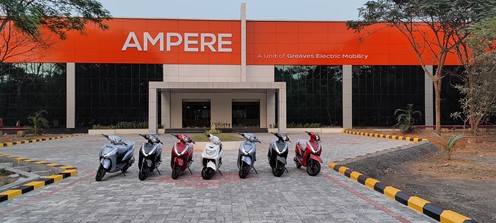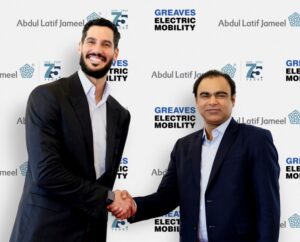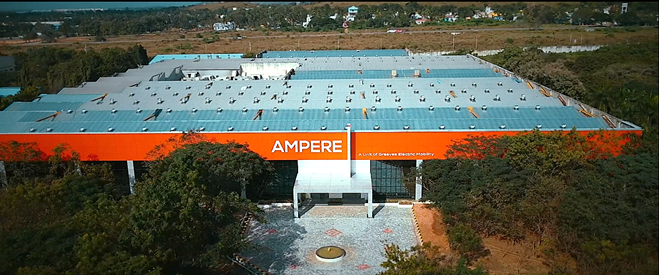Partners in India’s e-mobility revolution
Abdul Latif Jameel’s recent – and major – investment of US$ 150m, (with a further commitment of US$ 70m in 12 months , if needed) in Greaves Electric Mobility (part of Greaves Cotton Ltd., (NSE: GREAVESCOT; BSE: 501455)) in June 2022, was the latest demonstration of its commitment to, and expertise in, the electrification of the burgeoning global mobility sector building on its automotive heritage which stretches back over three quarters of a century.

It was also its first investment in the fast-growing e-mobility sector in India – the world’s fourth largest automotive market in our planet’s second most populous nation at around 1.4 billion people.[1]
The deal marked one of the largest investments in the Indian two-to-three-wheeler space to-date with Abdul Latif Jameel acquiring a 35.8% fully diluted stake.
The investment also continues Abdul Latif Jameel’s ongoing strategy to invest in businesses that are driving the future of global sustainable mobility, including US-based electric adventure vehicle manufacturer RIVIAN and eVTOL personal electric air transport pioneer, Joby Aviation.
Through this latest strategic agreement, both parties will work together to accelerate the journey of Greaves Electric Mobility – already one of the fastest growing EV brands in the market – into a significant electric two-to-three-wheeler mobility player in India, and ultimately, to explore the potential to expand its portfolio to other markets across the Global South.
Hassan Jameel, Deputy President and Vice Chairman, Abdul Latif Jameel, visited India in August this year, to see first-hand the Company’s work to bring green mobility to India’s population. We caught up with him to discuss the investment, the opportunities he sees for growth and his hopes for the future.
Can you provide some context around this opportunity and the size of the mobility market in India?

HJ: India is currently the world’s fourth-largest automotive market. In 2017-18, i.e., pre-COVID, India became the sixth largest producer of automobiles in the world with an average annual production of 29 million vehicles per year. Of these, around 83% are two-wheelers (scooters and motorcycles) and three-wheelers.
Two-wheelers are generally purchased for personal use, but they are also widely used by many so-called ‘last-mile delivery’ operators. Three-wheelers on the other hand are bought for almost wholly commercial use, to move both people and goods around urban environments.
Electric penetration has been quite low – around 1% in two-wheelers in 2021 – but it is increasing quickly in both the two-wheeler and three-wheeler segments. In May 2022, for the first time ever, electric three-wheelers outsold internal combustion engine (ICE) models, predominantly through the e-rickshaw segment.. That is a much faster transition than most people expected, and much faster than the two-wheeler market, where electric penetration is still only around 4-5% month-on-month since December 2021.
This is expected to increase significantly within the next three-to-five years, with the Indian Government targeting most of this segment to become electrical by 2030, at the latest.
One of the main reasons for the success of electric models in the two and three-wheeler segment is a government subsidy scheme called FAME II. This is designed to increase the take-up by ensuring they can compete on price with ICE models, helping India to meet its net-zero commitments and reducing urban pollution levels, which are among the highest in the world.
Global fuel prices have also been very volatile, which has prompted people to look at other, more sustainable, alternatives.
Besides these advantages, the running costs and total cost of ownership scale has now tilted towards the electric micro-mobility segment.

When did you first become aware of Greaves Electric Mobility?
HJ: We first came across them last year, but we only started working seriously on the investment proposal in January 2022. We had to move quickly as we were competing against some other large investment firms.
What convinced you they were the right company to invest in?
HJ: There were three elements to it.
First, we did a lot of research and due diligence on both Greaves Electric Mobility and the parent company, Greaves Cotton. Greaves Cotton is a very old company, founded in the middle of the 19th Century. It was bought by the Thapar family around 1947. Mr. Karan Thapar is the current Chairman.
Under the ownership of the Thapar family the company had achieved a 75% share of the traditional power train market for three-wheelers diesel engines in India. It is a similar story to Abdul Latif Jameel in a way – a well-established, family-owned business, very successful in its key markets, and with a strong brand name and values that reflect our own.
Second, we met the management of Greaves Electric Mobility and Greaves Cotton and were very impressed by the quality of the team, their approach to recruitment and retention, and how they value and develop their people.

The third aspect was about the products themselves. Of course products are well designed, popular and reliable, with a strong and growing reputation in the market. The two-wheelers are sold under the brand name ‘Ampere’. In mid-2021, Ampere had a market share for registered retail sales of around 5% to 6%.
By June this year that had increased to around 15%. They are now amongst the major electric 2-wheeler (E2W) players in the market, which has only served to confirm our strong belief in their capabilities and their potential. Something about early mover advantage would be nice to have here.
Greaves had the foresight to spot a great Indian opportunity and was the first mover in the world of EVs much before anyone else. It’s portfolio of 2 & 3 wheelers appeal to both the B2B and B2C segments.

How competitive is the two and three-wheeler electric mobility market?
HJ: It’s very competitive and becoming more so. There are numerous new players trying to enter the market and take advantage of the attractive government subsidies for two-wheeler electric scooters.
At the same time, existing scooter manufacturers that have dominated the ICE segment in two-wheelers are also looking to enter the e-mobility space. At some point, the Government subsidy regime will be removed. I expect we will end up with a few serious long-term players who are able to offer an attractive proposition that combines not only the quality of the product, but also the highest levels of pre-and post-sales customer service, and the right brand perception.

On the three-wheeler side, most of the major traditional players have not entered the electric market in a big way yet. But it is only a matter of time before they do, and we will have to show that we can compete with them.
For e-rickshaws the market is very fragmented, with 70%-80% of the market made up of small less well organized local players. The market is developing fast, though. Regulations are getting tighter, and standards are improving, so I expect we will see some consolidation as serious players move into the market.
How comprehensive is the infrastructure for e-mobility in India?
HJ: At the moment, in terms of charging infrastructure, there is a little bit of everything in the Indian market, because it is still in the early stages of development.
Most scooters are typically charged at home using fast chargers. So just like you charge your phone overnight, you can charge your scooter overnight.
In the case of Greaves’ electric scooters, the battery is also portable. You simply take it out, plug it in and charge it up in around four hours.

Other providers offer fixed batteries that come with regular and rapid fast chargers. And there are some that provide battery swapping. The range for a fully charged battery is usually around 80-100km. The average daily distance people drive is around 20-40 km, depending on the size of the cities, so this is sufficient ,currently, for most people.
The Indian Government is also doing a lot of work around charging infrastructure, particularly around the introduction of a battery swapping policy.
Range anxiety is still a concern for many people, especially as the charging infrastructure is still in its nascent state. By introducing battery swapping, where an electric scooter or three-wheeler can go into any swapping station and exchange a depleted battery for a fully charged one, the Government hopes to address this issue and encourage more people to choose electric.
How does this investment fit in to Abdul Latif Jameel’s mobility strategy?
HJ: Abdul Latif Jameel’s mobility strategy has three core pillars: design, distribute and invest. There are partnerships where we do one of these, two of these, or all three of them. I think our partnership with Greaves will involve all three.
We will help them design the best products for the market. We can use our existing global infrastructure and experience to strengthen and potentially expand distribution. And of course, we have already invested in them to help them make the most of opportunities in their chosen markets.
So, in that sense, this Greaves investment is a perfect fit for our overarching mobility strategy.
And how does it fit in to Abdul Latif Jameel’s net zero and decarbonization objectives?
HJ: Abdul Latif Jameel has a long-standing commitment to sustainability in general, and to net zero and decarbonization in particular.

We have invested significantly in clean energy through Fotowatio Renewable Ventures (FRV), our flagship renewable energy business, and to water efficiency, through Almar Water Solutions.
We are also heavily involved in the electric mobility sector, particularly though our existing investments in RIVIAN, a global leader in electric vehicles, and Joby Aviation, which is pioneering the development of electric vertical take-off and landing (eVTOL) aircraft.
Our investment in Greaves Electric Mobility reflects this ongoing interest and commitment to the global energy transformation and to the net zero objectives of the Paris Agreement.
Greaves Electric Mobility currently focuses on the Indian market. Do you envisage any international expansion in future?
HJ: Our immediate priority is India, for the next three to four years at the very least. The Indian electric mobility market is growing rapidly and there is an opportunity to shape it.
We need to maintain our focus on responding to that growth and capitalizing on the opportunities it presents, specifically in the two and three-wheelers segments. We want to grow our market share and cement our position as the leader in these categories.
Having said that, this is not only a financial investment. We are also a strategic partner for Greaves Electric Mobility.

This means being open to new opportunities for growth, particularly in the Global South – from across South and Southeast Asia, into the Middle East and Africa and potentially Latin America too – tapping into Abdul Latif Jameel’s existing infrastructure and presence in key markets.
How involved will Abdul Latif Jameel be in Greaves’ operations on a day-to-day basis?

Photo Credit: © Abdul Latif Jameel.
HJ: One of the key reasons we partnered with Greaves Electric Mobility is because we could see they have a very strong management team, with a clear and well-defined strategy. We invested in them because we truly believe in them. We are new to this (2 and 3-wheeler) market. They do not need us to tell them how to run their business – they are already doing a fantastic job.
At the same time, from a strategic point of view, we have our own strengths around distribution, logistics, infrastructure, international relationships, and so forth. This is where we can truly add value. We hope to bring all these resources, expertise and experience to Greaves Electric Mobility to help them activate their potential and achieve their objectives.
That’s why we are there. We are on the management board and, of course, being board members, we will play a role as an enabler and facilitator of growth, but we do not intend to get in the way at an operational level.
Is Abdul Latif Jameel planning further investment in the electric mobility market in the future?
HJ: We continue to look at potential opportunities for strategic partnerships that fit with our long-term approach. We are not only financial investors looking to maximize short term profit and make a quick exit. We’ve already demonstrated through our investments in RIVIAN, Joby Aviation and a host of others, that we look to build true value through long-term partnerships – we have been partners with Toyota Motor Corporation for over 67 years (since 1955).

This approach helps dynamic, sustainable businesses to achieve their- and our – goals.
So, yes, of course, we are always looking for new investment opportunities in this sector that align with our strategy and our vision. I can’t say what and where that might be – but that is part of the challenge; finding those opportunities and helping those businesses to realize their potential and move toward a more beautiful tomorrow.
[1] Est. 2021, Our World in Data: Population & Demography Explorer, July 2022





 1x
1x

 Added to press kit
Added to press kit


